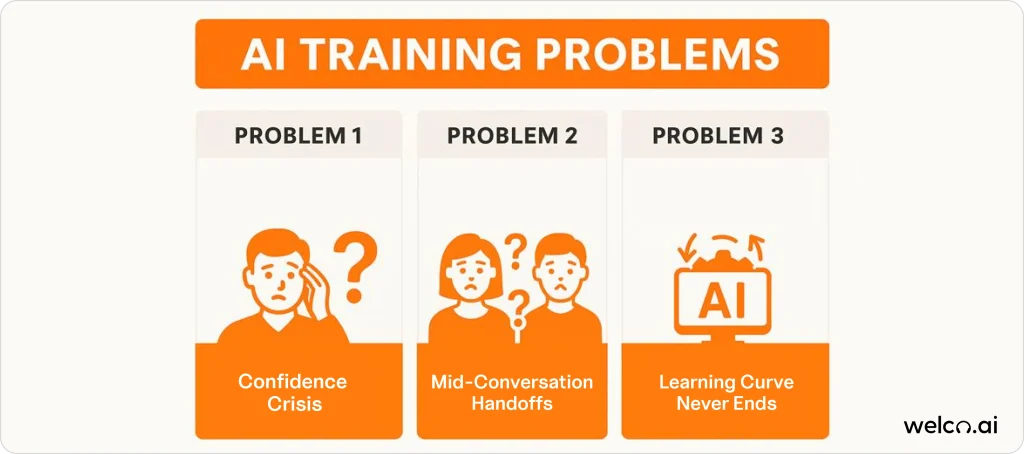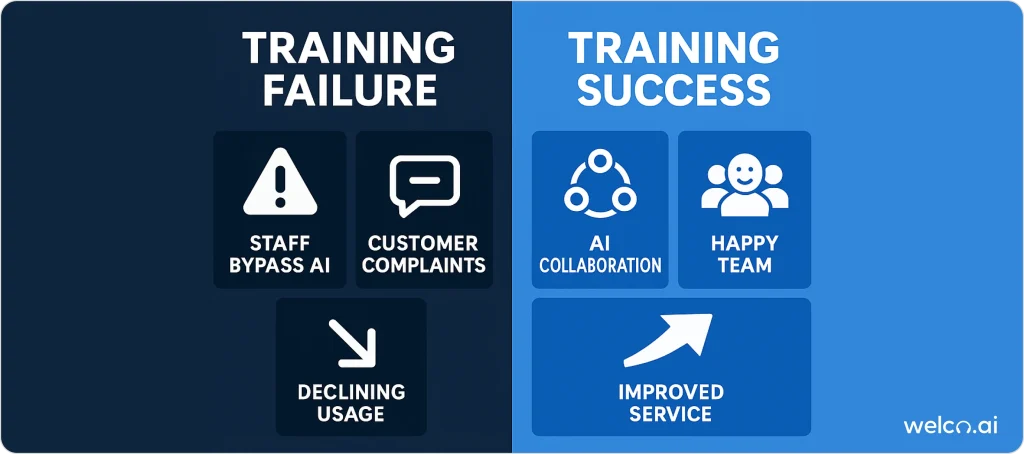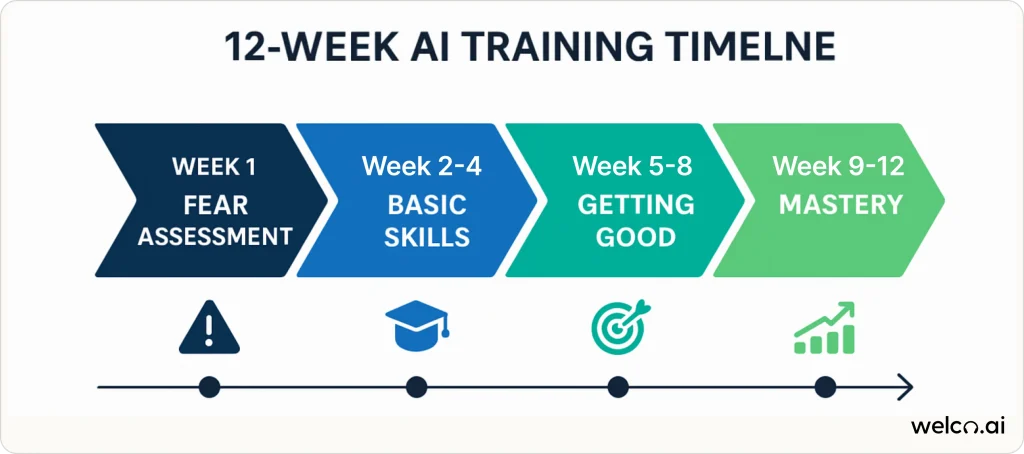I thought Jennifer’s $25,000 AI receptionist would solve everything.
I was wrong.
Three weeks after installation, her system sat completely silent while phones rang and her team scrambled to answer calls manually. Her staff had found every creative excuse to bypass the AI:
“The system was down.”
“I didn’t hear the notification.”
“The customer seemed upset, so I took over immediately.”
Sound familiar?
Jennifer’s problem wasn’t the technology—it was that nobody taught her team how to work with something that thinks, learns, and sometimes gets things spectacularly wrong.
Six months later, Jennifer had to let go of two employees who never adapted, and the AI system is still gathering dust.
After watching this same disaster play out at company after company, I learned something crucial: this isn’t about teaching software features. It’s about teaching humans to collaborate with artificial intelligence.
And that requires a completely different approach than traditional employee technology training.
Understanding the complete cost picture helps you realize why proper AI workplace training is essential—failed implementations waste both money and team morale.
The Real Problem: AI Doesn’t Follow Rules
Here’s what makes AI technology training different from every other workplace technology:
Traditional software is predictable. Click button A, get result B, every single time.
AI receptionists are intelligent but inconsistent. They might handle the same customer question three different ways depending on context, recent training, or AI confidence scoring.

This unpredictability terrifies staff who are used to systems that behave the same way every time.
The 3 Problems That Kill AI Training
Problem #1: The Confidence Crisis
Your receptionist handles a call perfectly using AI assistance on Monday. On Tuesday, the AI suggests a different approach for a similar call.
Staff lose confidence because they can’t predict what the AI will do.
What actually works: Train people to read AI confidence scores. When the system says “I’m 60% confident about this answer,” that’s your cue to step in.
Problem #2: Taking Over Without Confusing Customers
Unlike regular software, AI receptionists require mid-conversation handoffs. Staff need to take control without making customers feel like they’re being transferred to a different person.
What actually works: Practice AI handoff traininguntil they feel natural. “Let me help you with that personally” works better than “Hold on, the computer messed up.”
Problem #3: The Learning Curve Never Ends
AI systems get smarter over time, which means they handle situations differently as they learn. This isn’t a bug—it’s a feature. But it confuses staff who expect consistent behavior.
What actually works: Frame AI evolution as improvement, not unpredictability. “The system learned from yesterday’s call and now handles these requests better.”
What to Say When Things Go Wrong
Here are the specific phrases that make AI handoffs smooth:
When a customer asks for a human: “I’m here to help you personally. Let me take care of that for you.”
When the AI gives conflicting information: “Let me verify that information for you to make sure we have it exactly right.”
When you need to correct the AI: “I have the most current information on that. Here’s what I can tell you…”
When the AI can’t understand the customer: “I can see this is a unique situation. Let me handle this personally.”
What Actually Works: Fear First, Features Second
Based on real implementations, here’s what separates successful AI training strategies from expensive failures:
Step 1: Address the Fears (Week 1)
Start with fears, not features.
I sit down with each team member individually and ask: “What worries you most about working with AI?”
Common responses:
- “What if it gives a customer wrong information?”
- “Will I look stupid when I don’t know how to fix it?”
- “Is this just the first step toward replacing me?”
Address these directly:
- Show them the AI confidence indicators so they know when to trust it
- Explain exactly when and how to override the system
- Demonstrate how AI handles boring tasks so they can focus on complex problems
Real example: At a legal firm in Portland, the most resistant paralegal became the biggest AI advocate after I showed her how the system flagged potential conflicts she’d missed manually.
The broader organizational approach to overcoming staff resistance to AI training is covered in our comprehensive change management guide.
Step 2: Build New Skills (Weeks 2-6)
This isn’t about software training—it’s about developing new professional skills:
Reading AI Cues:
- When is the AI certain vs. guessing?
- What makes the AI ask for human help?
- How do you know if the AI understood correctly?
Taking Over Smoothly:
- Taking control mid-conversation without confusing customers
- Correcting AI mistakes while maintaining professionalism
- Knowing when to let AI continue versus when to intervene
Working Together:
- Using AI suggestions as starting points, not final answers
- Teaching the AI better responses through feedback
- Recognizing patterns the AI misses
Step 3: Getting Really Good at This (Weeks 7-12)
The goal: Staff see AI as a smart assistant, not a replacement or threat.
Advanced skills:
- Understanding customer history from AI conversation summaries
- Using AI insights to identify opportunities
- Teaching the AI your industry’s specific terminology
- Leveraging AI data to improve overall customer service
Real success story: A dental practice receptionist noticed the AI was categorizing “teeth cleaning” and “dental prophylaxis” as different services. She taught the system they were the same, improving scheduling accuracy for the entire office.

When Training Fails (The Honest Truth)
Sometimes workplace AI adoption doesn’t work, despite best efforts. Here are the warning signs:
Red flags after 4-6 weeks:
- Staff still bypass AI for routine calls
- Customer complaints about inconsistent service
- AI usage metrics show declining adoption
- Team morale problems related to technology
When to pivot:
- If resistance increases after month 2
- When training costs exceed projected AI savings
- If key staff threaten to quit over AI implementation
The uncomfortable truth: About 15-20% of staff never fully adapt to human AI collaboration. Plan for this reality, not against it.
Measuring What Actually Matters
Track these indicators:
Staff AI Integration:
- Monthly surveys: “How comfortable are you with AI handoffs?” (1-10 scale)
- Usage patterns: Are staff using AI features or finding workarounds?
- Error rates: How often do staff corrections improve AI performance?
Customer Experience:
- Satisfaction scores: Compare AI-assisted vs. human-only interactions
- Resolution times: Are AI collaborations faster or slower?
- Complaint patterns: What types of issues increase during training?
Timeline Expectations:
- Month 1: 40-50% comfort level (learning period)
- Month 3: 70-80% confidence (getting comfortable)
- Month 6: 85%+ proficiency (working smoothly)
Your Training Action Plan
Week 1: Fear Assessment
- Individual conversations with each team member
- Identify training champions and resistors
- Address specific concerns about AI collaboration
- Set realistic expectations for training timeline
Weeks 2-4: Basic Skills
- Understanding confidence scores and escalation triggers
- Practice safe handoff techniques
- Learn when to trust vs. override AI decisions
- Start with low-risk scenarios (after-hours, basic info)

Weeks 5-8: Getting Good at This
- Handle complex customer situations with AI assistance
- Use AI insights to improve customer service
- Teach AI better responses through feedback
- Integrate AI into daily workflows
Weeks 9-12: Mastery
- Customize AI responses for your specific business
- Develop best practices for your team
- Train newer employees on AI collaboration
- Continuous improvement based on performance data
For businesses operating multiple locations, maintaining training consistency becomes crucial. Our scaling strategies guide provides specific frameworks for ensuring quality training across distributed teams.
The Bottom Line: It’s About Partnership
The businesses succeeding with AI receptionists understand one fundamental truth: this technology works best when humans and AI collaborate, not when AI replaces humans.
Your staff’s value increases when they learn to work with AI effectively. They become more efficient, handle more complex problems, and provide better customer service.
But this only happens with proper AI staff onboarding that addresses the unique challenges of working with intelligent, adaptive technology.
The companies that skip this training—or treat it like regular software training—end up with expensive systems that nobody uses.
Beyond training benefits, successful AI implementations also build business continuity capabilities that protect your operations during crisis situations when traditional phone systems fail.
Don’t let that be you.
Frequently Asked Questions
My team keeps “forgetting” to use the AI system and just answers calls themselves. How do I know if they’re genuinely struggling or just being stubborn?
Look for specific patterns. Genuine struggle shows up as questions about when to take over or requests for more practice. Stubbornness looks like complete avoidance, complaints that “customers don’t like it,” or bypass excuses that don’t match reality. If they’re asking how to do it better, they’re struggling. If they’re explaining why they shouldn’t do it at all, that’s resistance.
Our AI gave a customer completely wrong information about our pricing, and now that customer is angry at us. How do I rebuild trust with my team after something like this?
First, fix the immediate problem with the customer and update the AI training to prevent repeats. Then address your team directly: acknowledge the mistake, show them what you’ve changed, and give them clear protocols for pricing questions going forward. Use this as a teaching moment—show them how to spot when AI might be uncertain about pricing and when to take over immediately.
I spent weeks training my receptionist on the AI system, but she quit anyway. Now I have to start over with someone new. How do I avoid this happening again?
Start by asking why she really left—was it the AI specifically or other job factors? For your new hire, involve them in the decision to use AI if possible, set clearer expectations about the role evolution upfront, and make sure the job description reflects that AI collaboration is part of the position. Some people genuinely aren’t a fit for AI-augmented roles, and that’s okay.
The AI handles simple calls fine, but when customers get frustrated and want to “speak to a human,” the handoff is always awkward. My staff don’t know how to take over smoothly.
Practice specific handoff scenarios until they become natural. The key phrase that works: “I’m here to help you personally.” Then immediately address their concern without mentioning the AI again. Train your staff to listen to what made the customer frustrated with the AI, then start fresh rather than trying to continue where the AI left off.
My business is too small to have dedicated training time. We’re all wearing multiple hats already. Is there a way to do this without taking everyone away from their regular work?
Small businesses actually have advantages here. Start with just 15-minute daily check-ins during the first week to address fears and questions. Use real calls as training opportunities—when something goes well or poorly, take 2 minutes afterward to discuss what happened. Pair your most comfortable person with your most resistant for peer learning. The key is making it part of daily work, not separate from it.
